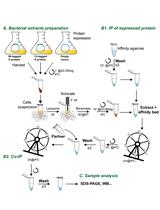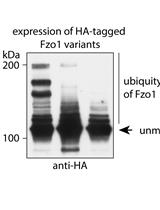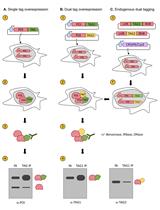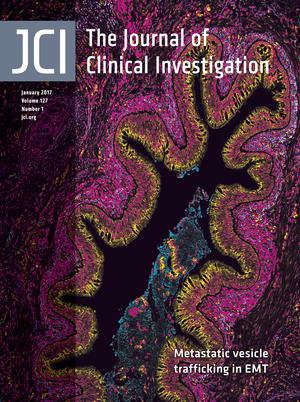- Submit a Protocol
- Receive Our Alerts
- Log in
- /
- Sign up
- My Bio Page
- Edit My Profile
- Change Password
- Log Out
- EN
- EN - English
- CN - 中文
- Protocols
- Articles and Issues
- For Authors
- About
- Become a Reviewer
- EN - English
- CN - 中文
- Home
- Protocols
- Articles and Issues
- For Authors
- About
- Become a Reviewer
Assessment of Modulation of Protein Stability Using Pulse-chase Method
Published: Vol 7, Iss 16, Aug 20, 2017 DOI: 10.21769/BioProtoc.2443 Views: 12050
Reviewed by: Jia LiMohan TCAnonymous reviewer(s)

Protocol Collections
Comprehensive collections of detailed, peer-reviewed protocols focusing on specific topics
Related protocols

Analysis of Direct Interaction between Viral DNA-binding Proteins by Protein Pull-down Co-immunoprecipitation Assay
Ana Lechuga [...] Modesto Redrejo-Rodríguez
Jan 5, 2018 12233 Views

Separation and Visualization of Low Abundant Ubiquitylated Forms
Ramona Schuster [...] Mafalda Escobar-Henriques
Nov 20, 2018 5417 Views

Assessing Self-interaction of Mammalian Nuclear Proteins by Co-immunoprecipitation
Claudia Cattoglio [...] Anders S. Hansen
Feb 20, 2020 9295 Views
Abstract
Pulse-chase technique is a method widely used to assess protein or mRNA stability. The principle of pulse-chase relies on labeling proteins or mRNA produced during a short period of time called ‘pulse’ and then following the rate of disappearance of those labeled proteins over a period of time called ‘chase’. This technique thus allows quantitative analysis of modulation of protein or mRNA stability under different treatments or culturing conditions.
Keywords: Pulse-chaseBackground
Pulse-chase technique is a method that involves culturing cells in a medium containing labeled amino acids for a short period of time known as ‘pulse’. This results in the generation of newly-synthesized polypeptides incorporating labeled amino acids. The pulse step is followed by a ‘chase’ step in which labeling medium is washed out to terminate the labeling process and is replaced by a medium with non-labeled amino acids to allow for the quantification of the initially synthesized radiolabeled proteins at any given time during this chase phase. This technique thus allows quantitative analysis of the processing of a protein of interest from synthesis to degradation in a timely fashion. Pulse-chase method can be used to analyze a variety of processes such as protein folding, co-translational modifications and intracellular transport (Jansens and Braakman 2003; Magadán, 2014). However, pulse-chase technique is most commonly used to assess the stability of a protein under different experimental conditions.
Radioactivity is a commonly used label. Labeling is usually done for proteins using radioactive S35 Methionine. The kinetics of disappearance of the radiolabeled proteins relies on how fast these proteins get degraded which can be exploited to examine the effect of different experimental conditions on protein stability. To assess the stability of a particular protein of interest, this protein is immunoprecipitated from all other immunolabeled proteins that were produced during the pulse period using a specific antibody. Immunoprecipitation will isolate a ratio of radiolabeled protein that was produced during the pulse and has not been degraded until the time of immunoprecipitation. Then radioactivity is measured to assess the relative amounts of labeled protein over a period of time.
While the focus of this protocol is the assessment of protein stability, pulse-chase method can also be used to assess the stability of mRNA. Labeling of mRNA during the pulse step can be done using 3UTP. Quantitative analysis of mRNA of interest then follows by taking aliquots of total mRNA at different time points and applying one of two methods: 1) Dot blot method in which the labeled mRNA of interest anneals to a complementary single stranded nucleic acid attached to a filter paper, other labeled mRNA are then washed out and radioactivity is measured by autoradiogram or scintillation counting, 2) Affinity purification method in which the labeled mRNA of interest anneals to a complementary anchored RNA/DNA immobilized to beads, the beads are then collected by centrifugation and radioactivity of the captured labeled mRNA is quantified.
Materials and Reagents
Other than the materials routinely used for mainlining cells in tissue culture and for immunoprecipitation and SDS-PAGE, the specific reagents required for the pulse-chase experiment are:
- Pipette tips
- 1.5 ml micro-centrifuge tubes
- Cell culture dishes
- Plastic cell scraper
- Tissue culture medium, appropriate for the cell line used, without methionine and cysteine
- DPBS
- Dithiothreitol (DTT)
- Protease inhibitor cocktail
- Phosphatase inhibitor cocktail (Sigma-Aldrich, catalog number: P2850 )
- N-Ethylmaleimide (NEM) (Sigma-Aldrich, catalog number: R3876 )
Note: This product has been discontinued. - Bradford colorimetric assay
- Protein A-Sepharose bead
- [35S]-Methionine (PerkinElmer, catalog number: NEG709A500UC )
- Methionine (250 mM in H2O, store at -20 °C) (Sigma-Aldrich, catalog number: M5308 )
- Cysteine (500 mM in H2O, store at -20 °C) (Sigma-Aldrich, catalog number: C7352 )
- Sodium chloride (NaCl)
- Triton X-100
- Ethylenediaminetetraacetic acid (EDTA)
- Glycerol
- Tris-HCl
- Sodium dodecyl sulfate (SDS)
- Methanol
- Acetic acid
- Pulse (labeling) medium (see Recipes)
- Chase medium (see Recipes)
- Lysis buffer (see Recipes)
- Wash buffer (see Recipes)
- Fixation solution (see Recipes)
Equipment
- Pipettes
- Refrigerated centrifuge
- 95 °C heat block
- Cell culture incubator (37 °C humidified 5% CO2)
- SDS-PAGE apparatus
- Radiographic cassette
- -80 °C freezer
- Ice buckets
- 37 °C water bath
- Aspiration flasks (Safety-approved for radiolabeled materials)
- Head over head rotator
- A gel drying equipment
Software
- ImageJ
Procedure
- Harvest around 1 x 106 adherent cells by trypsinization or collect 1-5 ml of cells that grow in suspension. Cells should be in subconfluent conditions.
- Centrifuge cells for 5 min at 300 x g at room temperature and aspirate the medium.
- Resuspend cell pellet in DPBS and wash twice with 10 ml pre-warmed DPBS by centrifugation.
- Resuspend cell pellet in 200-500 μl of the pulse medium (see Recipes).
- Incubate cells for the desired duration of the pulse in a 37 °C water bath.
- Terminate the pulse by centrifugation at 4 °C for 15 sec at maximal speed.
- Aspirate the supernatant and resuspend the cell pellet in 1 ml of chase medium (37 °C, see Recipes).
- Take aliquots at several time points (4-8 time points are usually sufficient). Intervals between time points should be determined according to the estimated half-life of the protein of interest. Transfer the aliquots to new 1.5 ml micro-centrifuge tubes containing 1 ml of ice-cold DPBS and keep on ice.
- Centrifuge cells for 15 sec at maximal speed at 4 °C.
- Aspirate the supernatant and resuspend the cell pellet in appropriate volume of ice-cold lysis buffer (see Recipes) freshly supplemented with 1 mM DTT, protease inhibitor cocktail, phosphatase inhibitor cocktail, 1 mM N-ethylmaleimide (NEM). Usually 1 million cells per 100 μl of lysis buffer gives a suitable concentration of cell lysates.
- Incubate cell lysates for 20 min at 4 °C (cold room) under slow rotation (2-5 x g).
- Centrifuge lysate for 15 min at 13,000 x g at 4 °C to remove insoluble materials and cell debris.
- Transfer the clear lysates to a fresh tube and discard the pellet.
Note: For adherent cells, this protocol can also be applied while cells are attached to the tissue culture dishes without trypsinization by using several dishes of cells at the same confluency, one for each time point. However, in that case the addition of pulse and chase media should be done quickly to avoid variation in pulse/chase time among dishes especially when applying short time intervals. Cell lysis in this case is done by adding the lysis buffer directly to cell monolayer while incubating on ice for 10 min then collecting the cell lysates using a scraper. Tubes containing the lysates are kept for another 10 min on ice with occasional inversion. Lysates are then centrifuged for 15 min at 13,000 x g at 4 °C to remove insoluble material and clear lysates are transferred to fresh tubes. - Quantify protein concentration in total cell lysates from different aliquots/time points using Bradford colorimetric assay and adjust the concentration of lysates using freshly added lysis buffer to approximately 1 mg/ml.
- Continue with the immunoprecipitation step: Add antibody against the protein of interest at the recommended dilution for immunoprecipitation application together with 50 μl 10% Protein A-Sepharose beads and 0.5 mg of protein (in about 500 μl of lysate). Shake or rotate head over head. Incubate under constant rotation at 4 °C for 1-2 h or overnight at 4 °C (cold room) under slow rotation (2-5 x g).
- Pellet the immunoprecipitated complexes by centrifugation at 300 x g for 2 min at 4 °C.
- Remove the supernatant and wash the bead complexes 3-4 times by centrifugation at 300 x g for 2 min and discarding the supernatant and adding 1 ml ice cold wash buffer (see Recipes).
- Resuspend beads in 20 µl of 4x SDS sample buffer and boil samples on a 95 °C heat block for 5 min.
- Load samples onto SDS-PAGE gels.
Note: The acrylamide percentage of acrylamide in the separation gel should be determined according to the size of protein of interest: the higher the molecular weight of the protein the less percentage gel to be used. - Run at constant 50 mA for stacking gel and 70 mA for separation gel.
- Fix gels with 10 ml fixation solution (50% methanol + 10% acetic acid) for 1 h at room temperature with slow rocking.
- Dry gels in a gel dryer for 1.5 h at -80 °C.
- Expose films to the radioactive gels overnight at room temperature.
- Quantify images of films using imaging software such as ImageJ.
Data analysis
Pulse-chase method is a powerful tool to study protein folding, maturation, intracellular transport and degradation. A practical example to demonstrate the power and applicability of pulse-chase technique was recently shown in Elgendy et al., 2017. In this study, pulse-chase technique was used to study the modulation of the stability of MCL-1 oncoprotein upon treatment of cancer cells with Sunitinib. Sunitinib, a multikinase inhibitor, is one of the most widely used targeted therapy (Elgendy, 2017). Nevertheless, most patients eventually relapse secondary to sunitinib resistance (Cella et al., 2015). Our work demonstrated that sunitinib resistance is associated with enhanced stability of MCL-1 oncoprotein (Elgendy et al., 2017; Elgendy, 2017). MCL-1 is a pro-survival member of the Bcl-2 family of proteins that exhibits unique features including its tight regulations and short half-life (Elgendy et al., 2014; Elgendy and Minucci, 2015). Using pulse-chase method, sunitinib treatment has been shown to enhance the stability of MCL-1. Briefly, HCT116 cells were incubated in methionine/cysteine-free DMEM for 30 min followed by incubation in labeling medium containing 200-500 µCi of [35S] cysteine/methionine for 2 h at 37 °C. After labeling, the cells were chased with complete DMEM containing 10% FBS and 5 mM cold methionine at 37 °C and were either left untreated or were treated with sunitinib for the indicated time points. MCL-1 was then immunoprecipitated from the lysates and analyzed by autoradiography.
Notes
Immunoprecipitation protocol should be optimized for each protein of interest by fine tuning several variables to find the optimal combinations that give best signal to background ratio. The most important variables are:
- The composition of lysis and wash buffers, mainly the type and concentration of detergent used in the buffer as well as the stringency of the buffer. Some nuclear proteins and structural proteins will require harsh lysis conditions where the lysis buffer contains SDS.
- The concentrations of antibody used. Higher concentrations of the antibody can be used if the protein of interest is not so abundant.
- The amount of total lysates used. This is determined by the abundancy of the protein of interest in the cell type used. The higher the amount of lysates used the more non-specific binding to the beads and ultimately the higher the background will be.
- Including or excluding a pre-clearing step of the lysates by pre-incubation with beads alone or with control IgG without the specific antibody to get rid of the ‘sticky’ proteins that adhere non-specifically to the beads.
- The sequence and duration of incubation of antibody, beads and lysates. Usually shorter incubation time should be tried first to reduce the background which may be increased to overnight incubation at 4 °C if needed.
- The temperature and number of washing steps: the higher the temperature, the lower the background.
Recipes
- Pulse (labeling) medium
Cysteine and methionine-free tissue-culture medium containing:
10 mM HEPES, pH 7.4
125-500 μCi [35S]-cysteine and/or methionine/ml - Chase medium
Complete tissue-culture medium containing:
10 mM HEPES
5 mM cysteine
5 mM methionine - Lysis buffer
150 mM NaCl
50 mM HEPES, pH 7.5
1% Triton X-100
1 mM EDTA
10% glycerol - Wash buffer
20 mm Tris-HCl, pH 7.4
150 mm NaCl
0.1% SDS
1 mm EDTA - Fixation solution
50% methanol
10% acetic acid
Acknowledgments
This protocol was adapted from Elgendy et al. (2017). [Elgendy, M., Abdel-Aziz, A. K., Renne, S. L., Bornaghi, V., Procopio, G., Colecchia, M., Kanesvaran, R., Toh, C. K., Bossi, D., Pallavicini, I., Perez-Gracia, J. L., Lozano, M. D., Giandomenico, V., Mercurio, C., Lanfrancone, L., Fazio, N., Nole, F., Teh, B. T., Renne, G. and Minucci, S. (2017). Dual modulation of MCL-1 and mTOR determines the response to sunitinib. J Clin Invest 127(1): 153-168.] M.E .received funding from the Mahlke-Obermann Stiftung and the European Union's Seventh Framework Programme/FP7 Marie Curie Actions Grant Agreement No. 609431/INDICAR–Interdisciplinary Cancer Research.
References
- Cella, C. A., Minucci, S., Spada, F., Galdy, S., Elgendy, M., Ravenda, P. S., Zampino, M. G., Murgioni, S. and Fazio, N. (2015). Dual inhibition of mTOR pathway and VEGF signalling in neuroendocrine neoplasms: from bench to bedside. Cancer Treat Rev 41(9): 754-760.
- Elgendy, M. (2017). The yin yang of sunitinib: One drug, two doses, and multiple outcomes. Mol Cell Oncol 4(2): e1285385.
- Elgendy, M., Abdel-Aziz, A. K., Renne, S. L., Bornaghi, V., Procopio, G., Colecchia, M., Kanesvaran, R., Toh, C. K., Bossi, D., Pallavicini, I., Perez-Gracia, J. L., Lozano, M. D., Giandomenico, V., Mercurio, C., Lanfrancone, L., Fazio, N., Nole, F., Teh, B. T., Renne, G. and Minucci, S. (2017). Dual modulation of MCL-1 and mTOR determines the response to sunitinib. J Clin Invest 127(1): 153-168.
- Elgendy, M., Ciro, M., Abdel-Aziz, A. K., Belmonte, G., Dal Zuffo, R., Mercurio, C., Miracco, C., Lanfrancone, L., Foiani, M. and Minucci, S. (2014). Beclin 1 restrains tumorigenesis through Mcl-1 destabilization in an autophagy-independent reciprocal manner. Nat Commun 5: 5637.
- Elgendy, M. and Minucci, S. (2015). A novel autophagy-independent, oncosuppressive function of BECN1: Degradation of MCL1. Autophagy 11(3): 581-582.
- Jansens, A. and Braakman, I. (2003). Pulse-chase labeling techniques for the analysis of protein maturation and degradation. Methods Mol Biol 232: 133-145.
- Magadán, J. G. (2014). Radioactive pulse-chase analysis and immunoprecipitation. Bio Protoc 4(8).
Article Information
Copyright
© 2017 The Authors; exclusive licensee Bio-protocol LLC.
How to cite
Elgendy, M. (2017). Assessment of Modulation of Protein Stability Using Pulse-chase Method. Bio-protocol 7(16): e2443. DOI: 10.21769/BioProtoc.2443.
Category
Molecular Biology > Protein > Stability
Cell Biology > Cell-based analysis > Protein synthesis
Biochemistry > Protein > Immunodetection > Immunoprecipitation
Do you have any questions about this protocol?
Post your question to gather feedback from the community. We will also invite the authors of this article to respond.
Share
Bluesky
X
Copy link








